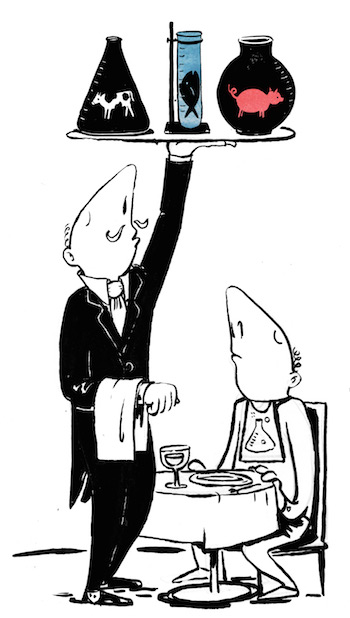ZEITGUIDE TO GMOs

Zeitguide “Food Image” by Kris Porter
Walk around New York City today, and you’ll see ads for Beanitos, “NYC’s newest superfood #beantastic.” It’s healthier than corn tortilla or potato chips, the ads claim, with more protein, more fiber, and no gluten. But what struck us was this label on the bottom: “NON-GMO PROJECT VERIFIED.”
Culturally speaking, the healthy food conversation keeps splintering: it’s not just “eat your veggies,” but buy organic without pesticides, avoid lactose or gluten, and take care of your gut bacteria. Add to that complexity GMOs – genetically modified organisms. These crop plants are lab-bred to have certain traits, such as disease or drought resistance, bug-killing toxins, or a tolerance for weed-killing chemicals.
GMOs have been in grocery stores for 20 years, since biotechnology company Calgene created the Flavr Savr, a tomato genetically engineered to suppress the enzyme that makes produce go soft so fast.
So why all the GMO talk right now?
1. In 20 states, legislation has been introduced aiming to force food companies to label GMO ingredients in their products. Vermont and Connecticut have already enacted labeling laws. According to The Atlantic, “More than a million people have signed a petition to the Food and Drug Administration asking it to label GMOs, the most of any petition in the agency’s history.”
2. Groceries and food producers are responding. A recent New York Times piece mentions that “Whole Foods has pledged that by 2018 it will replace some foods containing genetically modified ingredients and label others; signs in Trader Joe’s proclaim, ‘No G.M.O.s Sold Here.’ General Mills announced last week that it would stop using genetically modified ingredients in its Cheerios.”
3. Newer packaged food products such as Beanitos, Annie’s and Cliff Bars are seizing the opportunity to market their own products as GMO-free. Frankly, they don’t have to win the labeling fight; by showing themselves off as GMO-less, they cast a harsh light on the fact that 70% of packaged food currently does contain GMOs.
4. Big Ag isn’t taking this lying down. Last year, the agricultural giant Monsanto netted $10.3 billion in sales of genetically modified seeds and genetic licenses. Mandatory food labels could shrink that demand. An outright ban on GMOs, however, would have a huge effect on American agriculture: the country could need “an additional 300 million acres to make up for the crop-yield advantages lost,” according to Lee Quarles, public-affairs lead for Monsanto.
So the question is: What’s so bad about GMOs?
Do food shoppers need to know if there’s been tinkering to the wheat in their pita? Or is this just a fancy debate about marketing and market share? And in reality, are GMO’s harmful to us in the same way that pesticides may be?
Research on long-term health effects from GMOs is sparse. But the American Association for the Advancement of Science board came out strongly against labeling in 2012, saying, “The World Health Organization, the American Medical Association, the U.S. National Academy of Sciences, the British Royal Society, and every other respected organization that has examined the evidence has come to the same conclusion: consuming foods containing ingredients derived from GM crops is no riskier than consuming the same foods containing ingredients from crop plants modified by conventional plant improvement techniques.”
Opponents counter that we don’t fully know the risks. Anti-GMO crusader Jeffrey Smith claims that animals fed GMOs develop abnormal conditions, including cancer and early death. Others argue that GMOs could have delayed side effects, like smoking or chemical exposure. GMOs have been blamed, rightly or wrongly, in the die-off of pollen-transporting bees, for reducing biodiversity, and for a rise in childhood allergies, out-of-control superweeds, and even the suicide of cotton farmers in India who can’t afford GMO seeds.
But the other side of the story is that by 2050, there will be 9 billion people on our planet, all needing to eat. The UN projects we’ll need to grow 70% more food than we do today. If volatile weather from global warming continues, that will hurt crop yields.
As we discussed in ZEITGUIDE 2013, food pioneers suggest that instead of engineering FrankenCrops, we should innovate farming methods: using polycultural planting , or encouraging the developing world to grow calorie-rich crops like cassava or bananas instead of corn. Also key: reducing waste. Currently a third of food is lost to waste and spoilage.
Will that be enough?
Soon many of us will face decisions about GMO ingredients, either in the voting booth or the supermarket aisle. Here in the western world, we may have the luxury of choosing. But in the developing world, will GMOs be a savior to those more vulnerable to starvation?
GMOs are indeed a hot topic now, and the debate will definitely continue.
Keep Learning,
Brad Grossman and TEAM ZEITGUIDE
